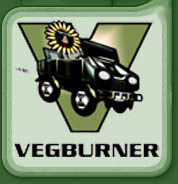Micro
Emulsions and Blends
Version 1.1 (22/11/2003)
Blends - Version 1.0
1 The Diesel Engine
2 Theory of Vegetable Oil Use as a
Fuel
3 Engine suitability
4 Heating the Oil
5 Biodiesel
6 Micro Emulsions and Blends
7 Vegetable Oil Engine Design
8 Vegetable Oil Furnaces and Heaters
9 Oil Types and Filtering
10 Taxation
11 Implications of Vegetable Oil
Fuel Use
12 Sources
Micro Emulsions and Blends
Vegetable oil has been mixed with alcohols, diesel fuel,
petrol, surfactants, cetane improvers, water (often as a component
of an aqueous alcohol) and solvents in varying mixes and proportions
to form a micro emulsion or blend. The resulting fuel is more
suitable than SVO for operation in diesel engines.
The suitability of a given fuel will depend on the exact
ingredients, the design of the engine and the ambient temperatures
encountered.
Simply mixing vegetable oil with diesel fuel has been shown
to be effective 50:50 to 80:20 blends have proven to be reliable
in most engines. Studies have found that a model 170F diesel
engine could be reliably fueled with a 30:70 cotton seed oil
and diesel blend[7]. Mc Donnell found that a blend of 25%
degummed and filtered rapeseed oil was suitable for use in
a DI engine[43]
The German company BioCar offer equipment to convert a vehicle
to run on vegetable oil using a dual tank system. They have
a device that monitors the viscosity of the fuel and mixes
diesel and heated vegetable oil to give suitable fuel viscosity.
Petrol and kerosene have proved to have a greater effect
over diesel with smaller proportions giving better results.
Detailed analysis of ethanol use has shown that particulates
are reduced by 50% by the addition of 9% of 95% ethanol (ethanol
with a 5% water content)[2]
Studies have also shown that short chain alcohols, act as
a suitable viscosity reducer. 1, 2 or 3-Butanol were found
to be most suitable although ethanol and methanol have both
been utilised.
Goering found that eight parts of soybean oil, when emulsified
with two part ethanol and five parts of 1-butanol as stabiliser,
performed as well as diesel fuel and was able to start a cold
engine.[1]
A micro-emulsion consisting of 53.3% soybean oil, 13.3%
of 95% aqueous ethanol and 33.4 vol-% 1-butanol was found
to perform comparably to diesel fuel [3].
Two studies of palm oil, diesel fuel and 5-10% water micro-emulsions
revealed performance comparable to diesel fuel with less engine
wear [4,5].
Schur tested blends of vegetable oil, petrol, alcohol and
biodiesel (RME) in different quantities to good results. He
found that the fuels were comparable to diesel fuel except
when run in DI engines at low engine loads.[6]
Long term durability and detailed exhaust emissions data
is incomplete due, in part, to the large number of possible
fuel blends each with unique characteristics.
1 The Diesel Engine
2 Theory of Vegetable Oil Use as a
Fuel
3 Engine suitability
4 Heating the Oil
5 Biodiesel
6 Micro Emulsions and Blends
7 Vegetable Oil Engine Design
8 Vegetable Oil Furnaces and Heaters
9 Oil Types and Filtering
10 Taxation
11 Implications of Vegetable Oil
Fuel Use
12 Sources
|



